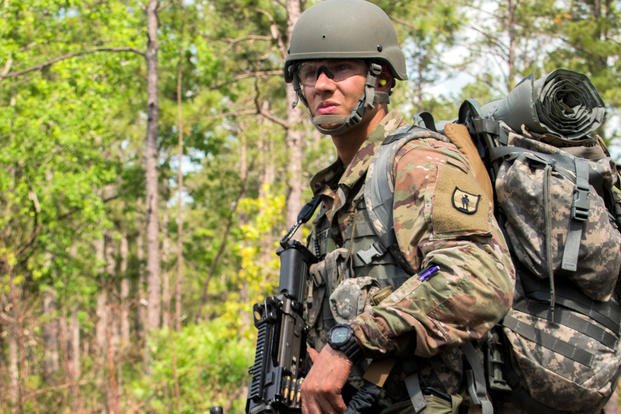The Army is finalizing a new, web-based modeling app -- developed by Microsoft -- that will allow soldier equipment officials to see how hanging new pieces of kit on close-combat troops could affect a squad's performance.
"For a long, long, long time, we have struggled with the ability to be able to show in a quantitative manner how a new component or an upgraded component will affect the effectiveness of a soldier and squad," John Howell, current lead for the Army's new Adaptative Squad Architecture effort, told an audience Tuesday.
He spoke at the first industry day for what Army officials hope will lead to a new framework developing future capability sets for dismounted soldiers that are far lighter and more streamlined than today's assortment of tactical gear.
While still in its early stages, the Architectural Assessment Tool is designed to be a collaborative tool for project managers and requirements officials to view digital models of soldiers kitted-out in current-issue gear to form a baseline.
Related content:
In a quick demo, Howell made a copy of the squad leader configuration baseline and then replaced his M4A1 with an M249 squad automatic weapon and the accessories needed for it.
"This is where you start to get into a little bit of the quantitative assessment piece," he said, showing how the app immediately calculates the weight added from the change. "What you notice immediately is that this special squad leader now weighs 30 pounds more."
It's a simple example, "but just to get to this point is quite a big step," Howell said. "In order to treat the soldier as an integrated weapons platform, this is the kind of thing you need to be able to do."
Adaptive Squad Architecture is the latest attempt by the Army to treat the soldier as a complete system, breaking away from the long practice of developing individual pieces of equipment and fielding them.
"We build the soldier out like a Christmas tree and our products are like ornaments, and we just continue to hang products off our soldiers until the soldier gets so heavy, they can't move," said Brig. Gen. Anthony Potts, head of Program Executive Office Soldier.
Potts told the mix of small and large defense companies in attendance that the Army needs a new approach to developing capability sets of equipment that are much lighter than the roughly 120-pound loads dismounted infantrymen carry today.
"If I can give you an architecture ... you can look at this and say, 'You know what? I've got an idea that I can combine three of those capabilities into one,'" Potts said. "Those three capabilities might weigh 4.5 today and you go, 'You know, I can bring it to one and I can bring it to you for 2.75 pounds.'
"Let me tell you something, if you do that, you have my interest."
In addition to the web-based assessment tool, the Army is also conducting evaluations that involve running infantry squads through tactical lanes at Camp Shelby, Mississippi, to build a database of performance data, Potts said.
"We are doing a correlation of data on squad performance, how the individual data on that soldier relates to the individual performance and how it relates to the entire squad's performance," he said, adding that he is sending a five-member team to Afghanistan in October to embed with the 75th Ranger Regiment to do more data collection.
"We want to be able to make data-driven decisions on some of the places we are going for in materiel development in the future," Potts said.
Under the soldier lethality priority in the Army's new modernization strategy, the service is developing advanced new kit such as the Integrated Visual Augmentation System, or IVAS, a Microsoft technology that will let soldiers view their weapon's sight reticle and other tactical information through a pair of tactical glasses.
The Army is also developing the Next Generation Squad Weapon, a replacement for the M4A1 and M249 that promises to offer significant weight savings on the weapon as well as the ammunition, Army officials have said.
But Potts realizes that it's still up to commanders to decide how much weight their soldiers carry into battle.
"A commander may believe that if we gave him 20% lighter ammunition or 30% lighter ammunition and he feels like the fight he's going into ... means he can take 20 or 30% [more ammo], that's a commander's call," he said.
On the other hand, Potts said a commander may decide "I'm going up a hill at 90 degrees; I'm going to take that 30% weight savings because that's what I think is the most important thing to me."
"I think what we are going to do is give commanders more options on what they can do with their formations that they have never had before, because the basic load that we will provide through the architecture will be lighter. ... As we draw down the weight of our body armor, draw down the weight of our ammunition, draw down the weight of our automatic weapons, you are going to free up space in there that's going to make it lighter," Potts said.
-- Matthew Cox can be reached at matthew.cox@military.com.













